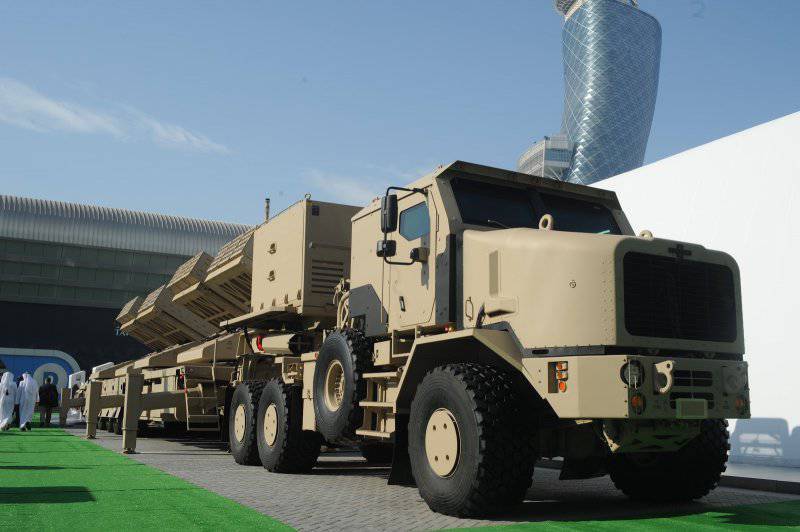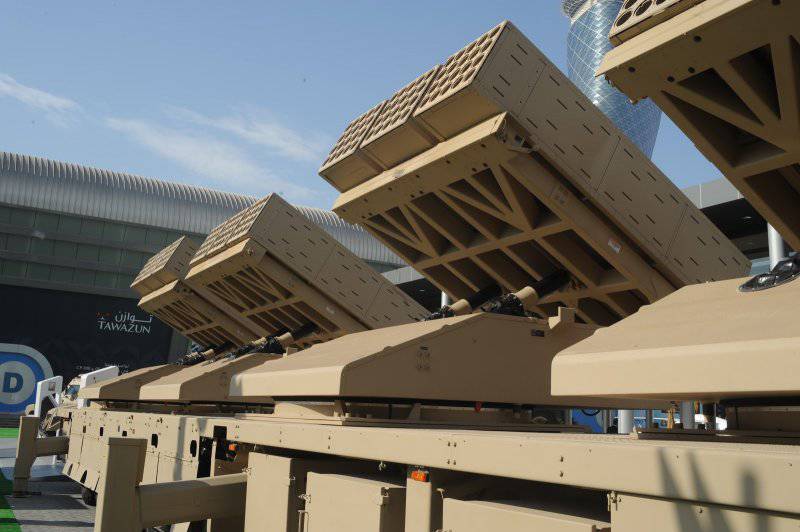Perspective MLRS MCL, or About quantity and quality
In general, the appearance of the new MLRS caliber 122 millimeter has long been no particular reaction. Many countries have similar systems, and each new one immediately gets the label “another one”. As for the Emirate MCL, it has one characteristic feature that determines its appearance and differences from the existing combat vehicles. The fact is that the engineers at Jobaria Defense Systems (JDS) decided to set a record in the area of salvo size. To this end, they supplied the new MLRS with more than hundreds of tubular guides for unguided rockets. You can imagine what effect will have only one salvo of one such combat vehicle.
The MCL (Multiple Cradle Launchers) combat vehicle is assembled on the basis of an Oshkosh HET truck tractor with an 6x6 wheel formula and a five-axle semi-trailer. The truck and a number of trailer units have anti-bullet and anti-fragmentation booking, which allows the use of a combat vehicle in war conditions. The American-made Oshkosh HET tractor is equipped with a Caterpillar C18 diesel engine with 700 horsepower. With such a power plant, the tractor is able to tow a trailer weighing up to 65 tons. Based on this, it is possible to draw some rough conclusions about the total mass of the MCL installation. Probably, the HET tractor was chosen not only because it was possible to put armor on it, but also because of its characteristics.
Apparently, all the fire control systems are installed in the cab of the tractor. According to the available data, the crew of the combat vehicle has an automated complex for determining its own coordinates and calculating guidance angles. It consists of inertial-satellite navigation system, ballistic computer and instrumentation control mechanisms. Among other things, the fire control system provides for the possibility of firing only from selected guide packages. Thus, the operator-gunner of the MLRS MCL can regulate the power of a volley in a fairly wide range.
An armored box with an auxiliary power unit is located in the front part of the semi-trailer, above the pivot of the fifth wheel coupling. As far as is known, it ensures the autonomous operation of all electric and hydraulic systems of a combat vehicle. The main part of the semi-trailer platform is occupied by four launchers. Each of them is mounted on its own turntable and can be raised to the required angle of elevation with the help of two hydraulic cylinders. The tilt-and-lift mechanism serves as the basis for three blocks with guides for rockets. Each of all 12 of such units of the machine incorporates on 19 (20) starting “pipes”. Stabilization of the semi-trailer when shooting is provided by six outriggers. The semi-trailer itself is hung on them, and the tractor remains on the ground.
Strangely enough is associated with the number of guides for unguided missiles. story. At the IDEX-2013, two MCL machines were exhibited. At one of them, which took part in demonstration performances, there were no middle guides in all blocks in the second row from the bottom of all the blocks. Because of this, there was evidence that the machine can transport and use up to 228 missiles at the same time. The second copy of the new MLRS was in the static exposition and all the guides were in place. Thus, its ammunition increased to 240 rockets. The reasons why 12 guides were not immediately installed on one of the machines have not yet been announced.
As the ammunition for the MLRS MCL, Roketsan TR-122 122-millimeter unguided rockets of Turkish design are used. According to available information, the company Roketsan and JDS have agreed on the subject of licensed production of missiles in the United Arab Emirates. TR-122 unguided rockets are designed for firing from 10 to 40 kilometers. The 65-kilogram shell with a length of slightly less than three meters is equipped with a high-explosive fragmentation warhead with a contact fuse. Each rocket carries an 6,5 kilogram of an explosive mixture based on RDX and TNT, which tears up the body of the warhead on 2000-2500 splinters. The rocket is guaranteed to hit targets within a radius of at least 20 meters. The Roketsan TR-122 family of missiles also contains ammunition with a warhead equipped with ready-made attack elements (5500 metal balls) and with a cluster. In the latter case, each unguided projectile carries fifty cumulative fragmentation combat elements and several incendiary ammunition. It is not yet known which types of TR-122 family of missiles were supplied to the United Arab Emirates and the production of which was deployed there.
The use of Turkish ammunition led to an interesting version regarding the structure of the MCL launcher. Although this version has not yet been confirmed and not refuted, it is worth considering. The latest modifications of the Turkish RSZO T-122 Sakarya, intended for the use of TR-122 missiles, do not have their own guides for ammunition. Before shooting, the calculation of the complex with the help of a crane of the transport-charging vehicle installs two units with rockets on the combat vehicle. These blocks are composed of transport-launch containers with missiles on 20. The unit is charged at the factory, then sealed and delivered to the troops. After making a salvo, the waste block is removed from the machine and disposed of. Its reuse is not provided. The use of identical missiles and a similar launcher structure (several blocks of 20 guides) led to the appearance of a version regarding the use of disposable missile blocks on the MCL. As already mentioned, this information is not officially confirmed, but at the same time it looks plausible enough.
To ensure combat work, a separate transport-loading vehicle is part of the MCL complex. It is mounted on the same base as the combat vehicle, but at the same time it is equipped with a crane and places for the transportation of missiles / rockets with rockets. It is argued that the full recharge of all 228 / 240 guides takes no more than an hour, which may speak in favor of the version about the use of ready-made blocks with ammunition. In addition, the advertising materials presented at the exhibition can be considered indirect evidence of this version. According to representatives of the company JDS, has already developed a version of the MLRS MCL, designed for firing Turkish TR-300 missiles of 300 caliber of millimeters. Such missiles with a trajectory correction system are capable of delivering a warhead to a distance of up to one hundred kilometers. It is worth noting that when using rockets of larger caliber, the MCL ammunition is reduced by more than an order of magnitude. At each launcher of the complex, two blocks of two transport and launch containers with missiles are mounted. Thus, MCL can attack enemy targets at a shorter distance, using all 228 / 240 missiles, or firing on, but sending only 16 missiles to the target at the same time.
According to Jane's Defense Weekly magazine, the MCL multiple launch rocket system has already entered service with the United Arab Emirates army. Prior to the exhibition in Abu Dhabi, the front units had time to get several such complexes. As we see, the command of the UAE army sees meaning in the creation and operation of such systems. However, experts and amateurs of military affairs are not inclined to greatly praise the MCL complex and greeted him with noticeable irony. First of all, the monstrous dimensions of the new combat vehicle were criticized. With all its advantages in terms of freight, the lengthy semi-trailer has a very specific cross-country ability. Obviously, the MCL combat vehicle will be able to move only along the roads, perhaps even along dirt roads. Rough terrain, in turn, will be impassable for it, or at least very difficult to move.
The second minus of this concept concerns the "concentration" of weapons. Battery conventional MLRS when firing spreads over a certain area. MCL, having firing possibilities similar to a small battery, can be disabled by one or two hits. To destroy the battery of "classic" systems of salvo fire, you will have to spend much more ammunition, and during the return fire several vehicles are guaranteed to leave the position. Thus, low survivability in a combat situation is added to the lack of permeability. Problems with permeability and survivability can have a tangible impact on the ways of applying the new MLRS. Moreover, they can put an end to possible export supplies. Therefore, it is very likely that the MCL complex will be procured only by the UAE army.
And still the question remains: if the MLRS ML is not suitable for cross-country movement and has very low chances of surviving counter-firing, then what tasks, other than advertising and exhibition ones, will be posed to it? Judging by the possibilities, the new MLRS can only get out of position if the enemy has no serious modern aviation and artillery. This fact, combined with the driving performance of a combat vehicle, directly speaks of the counterguerrilla nature of the possible use of MCL. During the Middle East military conflicts of recent times, the formation of insurgents almost did not have serious artillery weapons, and all the main battles took place in or near cities. Thus, the MCL multiple launch rocket system is adapted to fire at the rebel positions and destroy their objects. In the event of a strike by two hundred missiles, the camp or fortified position will be completely destroyed, and the military-technical backwardness of the enemy will not allow him to deliver a retaliatory strike in time or even to find out where the MCL system fired.
Thus, although MCL is unlikely to be able to work with sufficient efficiency in a full-fledged war with a serious adversary, it is quite capable of exporting. In recent years, several armed insurgencies have occurred in several countries in the Middle East and North Africa. Systems like MCL might be useful in such conditions. So in the very near future, the new MLRS can be exported. However, the commercial prospects of this system of salvo fire look ambiguous, if not to say strange. With similar performance with several combat vehicles like the BM-21 “Grad”, the MLC is more difficult, heavier and more expensive. In addition, her tactical niche is small and therefore a potential buyer must first think whether he needs such a combat vehicle and, if so, in what quantity.
At the present time, one cannot rule out such a scenario, in which only a few copies of the MCL complex will be produced and all of them will remain in the army of the United Arab Emirates. As part of the armed forces of this country, the machines will begin to expend their resources by participating in exhibitions and demonstration maneuvers. Because of its specific tactical niche, the MCL systems will only be useful if a poorly organized and poorly armed opponent appears. Will the Emirates have a similar enemy? It is difficult to speak with confidence. Probably, the command of this country does not exclude such a variant of further events.
On the materials of the sites:
http://idexuae.ae/
http://bbc.co.uk/
http://bmpd.livejournal.com/
http://oshkoshdefense.com/
http://roketsan.com.tr/
http://rbase.new-factoria.ru/


Information